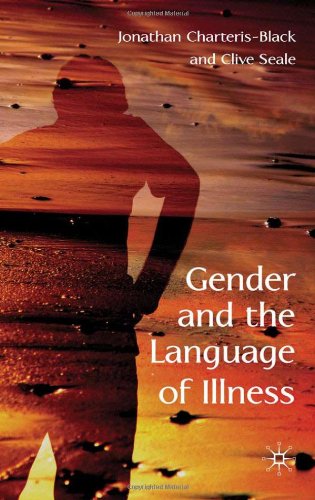

Most ebook files are in PDF format, so you can easily read them using various software such as Foxit Reader or directly on the Google Chrome browser.
Some ebook files are released by publishers in other formats such as .awz, .mobi, .epub, .fb2, etc. You may need to install specific software to read these formats on mobile/PC, such as Calibre.
Please read the tutorial at this link: https://ebookbell.com/faq
We offer FREE conversion to the popular formats you request; however, this may take some time. Therefore, right after payment, please email us, and we will try to provide the service as quickly as possible.
For some exceptional file formats or broken links (if any), please refrain from opening any disputes. Instead, email us first, and we will try to assist within a maximum of 6 hours.
EbookBell Team

4.8
14 reviews
ISBN 13: 9781349307906
Author: J Charteris Black, C Seale
An investigation of the influence of gender, social class, age and illness type in the language of people talking about their experiences of illness. It shows evidence of both conformity with and resistance to gender stereotypes.
1 Gender and the Language of Illness
1.1 Introduction – sex, gender and identity
1.2 Difference: Sex, sex roles and comparison
1.2.1 Introduction
1.2.2 Sex
1.2.3 Sex roles
1.2.4 Comparison of sex and sex roles
1.3 Gender as performance
1.3.1 Introduction
1.3.2 Communities of practice
1.3.3 Discourse
1.4 Illness, language and social variables
1.4.1 Illness and language
1.4.2 Illness and gender
1.4.3 Language and age
1.4.4 Language and social class
1.5 Summary
2 Methods for Investigating Gender and Language
2.1 Introduction
2.2 Variationist sociolinguistics
2.3 Corpus-based research
2.4 Concepts related to corpus research
2.4.1 Keywords
2.4.2 Key concepts
2.4.3 Keywords and key concepts compared
2.5 Deriving discourses from keywords and key concepts
2.6 Corpus and sub-corpora
2.6.1 The full matched sample
2.6.2 The social class (SEC) matched sample
2.6.3 The age matched sample
2.6.4 The specific illness sample
2.7 Summary
3 Men’s Traditional Discourse of Illness: Distancing and Avoidance
3.1 Introduction: Men and discourses of illness
3.2 Linguistic strategy: Reification
3.3 Linguistic strategy: Deictic distancing
3.4 Linguistic strategy: Distancing through abstractions
3.4.1 Introduction
3.4.2 ‘Solution/s’
3.4.3 ‘System/s’
3.4.4 ‘Pattern/s’ and ‘technique/s’
3.5 Discursive style: Avoidance through sports talk
3.6 Discursive style: Swearing
3.7 Summary
4 A Feminine Discourse of Illness: Transformation and Modality
4.1 Introduction
4.2 Feminine discourse of illness
4.2.1 Overview
4.2.2 Verb analysis
4.3 Feminine discursive style: Low modality
4.3.1 Analysis of mental process verb (cognitive): ‘Think/Thought’
4.3.2 Analysis of mental process verb (cognitive): ‘Mean’
4.3.3 Analysis of mental process verb (cognitive): ‘Imagine’
4.3.4 Analysis of mental process verb (cognitive): ‘Know’
4.4 Feminine discursive style: High modality
4.4.1 Analysis of mental process verb (cognitive): ‘Knew’
4.4.2 Analysis of mental process verb (affective): ‘Need’
4.4.3 Analysis of mental process verb (affective): ‘Want’
4.5 Summary
5 Emotional Disclosure: Socio-economic Classification, Age and Gender
5.1 Introduction: Gender and emotion
5.2 Socio-economic classification (SEC)
5.2.1 Overview – Emotional disclosure
5.2.2 Low SEC women
5.2.3 High SEC men
5.2.4 High SEC women
5.2.5 Low SEC men
5.3 Age and emotion
5.3.1 Overview
5.3.2 Younger men
5.3.3 Younger women
5.3.4 Older men
5.3.5 Older women
5.4 Summary
6 Experience of Support: Gender, Class and Age
6.1 Research on support
6.2 The experience of support
6.2.1 Overview
6.2.2 Gender specific use of support-related lexis
6.2.3 Socio-economic classification (SEC)
6.2.4 Age
6.3 Sources of support
6.4 Modes of communication
6.3.1 Men’s sources of support: ‘People: Male’ and ‘Belonging to a Group’
6.3.2 Women’s sources of support: ‘Kin’ and ‘family’
6.4 Modes of communication
6.4.1 Use of ‘talk’
6.4.2 Use of ‘phone’
6.4.3 Use of reported speech
6.4.4 Use of ‘write’
6.5 Summary
7 Illness Type and Gender
7.1 Introduction
7.2 The language of illness experience
7.3 Heart disease
7.3.1 Key concepts: Measurement and time
7.3.2 Lifestyle change and self-transformation
7.4 Interaction between heart disease and gender
7.4.1 Overview
7.4.2 Key concept analysis of gender and heart disease
7.5 Summary
8 Conclusion
Tags: J Charteris Black, C Seale, Gender, Language